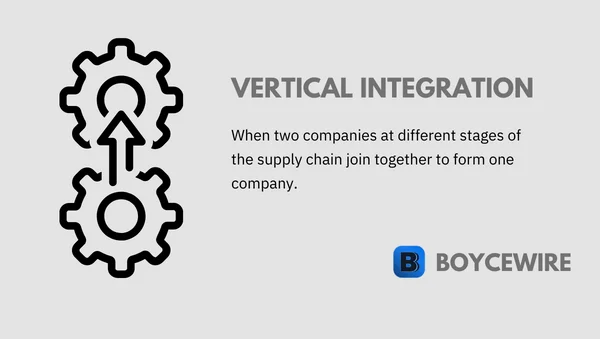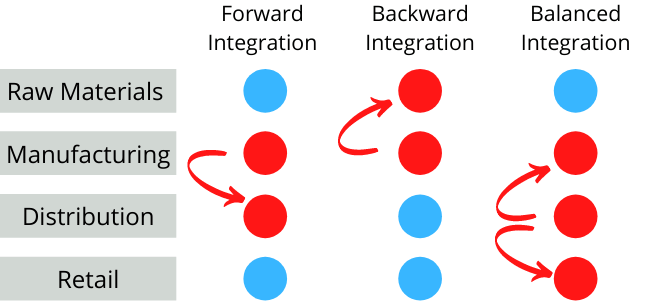Vertical Integration: Definition, Examples, Pros & Cons

What is Vertical Integration
Vertical integration is where two businesses at different stages of the supply chain join together. For instance, a business that relies on another for its supplies may find that it is unreliable, which is affecting business. In turn, it may vertically integrate with its supplier in order to reduce late deliveries and increase efficiencies.
Businesses will look to integrate in order to obtain greater control of the supply chain. Suppliers need buyers and buyers need suppliers. Yet there is a competitive aspect involved. There is nothing to stop either the supplier or buyer from doing their business elsewhere. By vertically integrating, the supplier no longer worries about having custom, and the buyer no longer worries about unreliable deliveries.
Key Points
- Vertical integration is where two companies at different stages of the supply change join together to form one company.
- There are three types of vertical integration – backward, forward, and balanced.
- Vertical integration allows the company to control the distribution or supply of its goods – allowing it greater control and efficiencies along the supply chain.
At the same time, the combined company benefits from the profits of both companies. This can effectively allow it to offer lower prices to the final consumer. For instance, chocolate manufacturing has many stages of the supply chain. Two of which are the processing of the cocoa beans, and another to manufacture the final chocolate bar.
Vertical integration occurs when the chocolate manufacturer (e.g. Mondelez) purchases a cocoa bean processor that is buying its beans from. As a result, the manufacturer can pay exactly the marginal cost – rather than profiting the processor. In turn, consumers may see lower prices in a competitive market place.
Vertical Integration Examples
Amazon
Amazon has vertically integrated much of its business. Not only does it act as a marketplace for buyers and sellers – but it also offers its own products and services, as well as its own distribution channel. So in effect, it has 3 stages in the supply chain. It sources the products, markets and sells them on its website, and then distributes them.
Carnegie Steel
Carnegie was a massive steel manufacturer in the late 19th century. It vertically integrated by acquiring companies before itself in the supply chain. The process of making steel requires raw material extraction – iron ore and coal. It then requires those materials to be refined before it is then sent to Carnegie Steel to manufacture into the final goods.
Carnegie Steel owned both the miners that extract the raw materials, as well as the refineries – thereby owning virtually the whole supply chain.
Ikea
Ikea is known as a flat-pack retailer that sells mostly wooden furniture, but also other fixtures and fittings. It is the last in the supply chain as it directly sells to the final consumer.
In 2015, Ikea made a huge step in ensuring complete vertical integration by purchasing a Romanian forest. The company added to this by purchasing forestland in Alabama in 2018 – aligning the companies aim to create a sustainable supply chain.
Not only does it now control much of the raw material production, but it also controls the manufacturing process through its subsidiary – Swedwood, which was renamed in 2013 to Ikea Industry. So it controls the production of the wood, the manufacturing process, and the final distribution through its retail units.
Netflix
Netflix is known as a provider for streaming services – the end of the supply chain where there is direct interaction with the consumer. It provides a platform for produces of films, TV, and other content. However, the company was reliant on third-parties to provide new content that its subscribers would like. At the same time, it had to pay a premium – particularly for big shows.
In 2013, Netflix decided to vertically integrate and enter the production business. So in turn, it not only produced shows and films but also provides the distribution network through its streaming services. This strategy has become vital as it has helped differentiate it from competitors and control the type of shows that are made available.
Zara
Zara is a Spanish clothing and accessory company that has over one thousand stores worldwide. Not only does it own its own retail stores and distribution, but the vast majority of its clothes are sourced in-house. Zara is vertically integrated with both the manufacturers and designs of its goods.
Whilst other stores rely on independent designers and manufacturers, they are left at their mercy. By contrast, Zara is able to adapt to new trends much quicker than its competitors. It has also led to improved efficiency in stock management – something that is crucially important in fashion design.
Types of Vertical Integration
There are three kinds of vertical integration:

Forward Vertical Integration
Forward vertical integration is where one company mergers, acquires or expands with a firm that is ahead of it in the supply chain. In its most basic form, the supply chain contains the raw material extractors, the manufacturers, and the retail distributors.
Forward vertical integration is where the company essentially mergers or buys its customer. For instance, EA sports manufacturers and designs video games. It is in the middle of the supply chain, so forward vertical integration would occur if it was to purchase a retailer such as Target or Gamestop.
Also known as upstream integration, this type of vertical integration is not so common. Generally speaking, it is the big retailers and the companies at the end of the chain that has the greatest purchasing power. This allows them to be the ‘predator’ rather than the ‘prey’ – meaning the firms at the end of the chain have the money to purchase companies behind them, whilst the opposite is true for firms earlier in the supply chain.
Part of the reason forward vertical integration is not common is because the companies at the end of the supply chain are usually very condensed. By contrast, there are thousands of suppliers that could only dream of integrating upwards. For instance, thousands of cocoa bean farmers supply Mondelez. Yet there is no way a small farming business in Columbia could afford to purchase or merge with Mondelez.
Backward Vertical Integration
Backward vertical integration is where a company joins with another that is at a stage before itself in the supply chain. In other words, it integrates with one of its suppliers. For instance, Ikea is dependent on manufacturers of wood. When it integrates with the manufacturer, we see backward vertical integration.
It is known at backward vertical integration because the firm is behind in the supply chain. So in a basic supply chain of raw material extraction, manufacturing, and distribution – the distributor could merge with the raw material extractor or the manufacturer and be classed as backward vertical integration. This is because they are at the stage behind in the supply chain.
Also known as downstream integration, this type of vertical integration is quite common. This is because big businesses at the end of the supply chain tend to have the purchasing power to consume their suppliers.
Balanced Integration
There is a third type of integration – balanced integration. This is quite simply a combination of both backward and forwards integration. For instance, balanced integration would be where a company mergers’ with both a company that is before it in the supply chain, as well as one that is after.
Therefore, balanced integration involves two transactions – one downstream, and another upstream. For example, Hershey relies on cocoa bean suppliers to provide it with its raw materials – it also relies on distributors such as Walmart and Target to sells its products.
An example of balanced integration would be if Hershey’s were to acquire both its coca bean suppliers AND a distributor such as Target. Obviously, this is a very rare type of integration that infrequently occurs – mainly due to the cost, but also due to potential legal disputes that may arise due to monopoly control of the vertical supply chain.
Advantages of Vertical Integration
1. Reliability
Many businesses face problems with their suppliers. This might be late deliveries, poor service, or failing to update and adapt to new trends. At the same time, suppliers may be situated in a location that is unfavourable – meaning deliveries take longer and are more likely to be late.
Through vertical integration, firms are able to benefit from a close co-operation between both parties. It controls that part of the supply chain, so difficulties can be ironed out. For instance, proximity issues may be addressed by moving facilities closer to each other.
2. Power over Suppliers/Buyers
Suppliers and buyers of goods may find themselves in a position whereby they are negotiating disadvantage. In other words, the company they are dealing with has many other options, whilst the company itself only has a few.
At the same time, certain players in the market might be difficult to work with, but are necessary in order to do business. By vertically integrating, businesses are able to avoid dealing with such companies, or at least better dictate terms and prices with them – after all, it owns one of its competitors.
3. Economies of Scale
It must be said that vertical integration does not benefit from economies of scale as greatly as horizontal integration. This is because the two companies are at different stages of the supply chain – so any overlap of industry expertise is unlikely to prove useful.
We also have the fact that it won’t benefit from an increase in production as the industries are completely different. Therefore, any cost benefits from lower unit costs will not occur under vertical integration – at least not to the same extent.
At the same time, there are economies of scale that can be achieved. Often businesses will have a number of suppliers, but if one is now integrated, it may make sense for it to become the sole provider. Therefore, it could benefit from lower unit costs through increased production from the supplier’s end.
There can also be some efficiencies achieve through an organisational perspective. Fewer employees are needed in jobs that overlap – HR and finance are examples. So fewer departments will be needed – saving costs in that regard.
4. Flexibility
When two firms at different stages of the supply chain join together, the feedback connection is enhanced. When trends or tastes are changing, this can be pro-actively fed back to the integrated suppliers who can then work on alternative solutions.
If we look at the Zara example again. It owns both the manufacturing and designing of its clothes. This allows it to have a greater say on what consumers like and want more of. The retail stores have the statistics and in turn, those can translate into actionable trends.
For instance, black leather trousers may not be selling well, so within a week, some alternative clothes can come in to replace them. The problem with having a supplier is that the buyer is not necessarily the only customer – so to drop everything and start something new is not plausible. Yet for an integrated company, it is.
5. Lower Consumer Prices
Each stage of the supply chain obtains some level of profit. So through vertical integration, the new firm is able to capture both sets of profits. At the same time, it can benefit from several economies of scale – thereby allowing it to charge lower prices.
In a competitive market, these cost savings are likely to be passed onto the consumer – providing it with a competitive advantage.
Disadvantages of Vertical Integration
1. High Costs
Vertical integration can be very expensive. Not only are there the financial costs, but also the time and effort to purchase as well as integrate the new firm. There are then additional costs such as moving factories and other facilities so they are closer to the purchasing company.
These can potentially prove to be wise investments, but at the same time, they are difficult to reverse. Once the investment is made, it can either be a success or failure – but the costs are significant nevertheless.
2. Management Difficulties
Owning a manufacturing business is very different from a retailer. Being a successful retailer does not make for a successful manufacturer. Some of the existing management may be kept on board to help in this regard. However, it can be very difficult for them to work in a new environment by which they have to answer to the parent company.
Conflicts can arise as a company goes from being independent to be told what to do – especially when the parent company has little experience in the industry. At the same time, there are also likely to be very different cultures at both companies. Those who work in the factories are different from those who work for the retailer – so may resent being given instruction from management.
3. Loss of Focus
Integrating a new company is a lot of work. Integrating a company that is at a different stage in the supply chain is even more difficult – particularly due to the lack of experience in that field.
At the same time, management may struggle to focus on its core competencies and instead focus on the integration and management of the new firm. This is why many companies often sell off divisions within their company as they can become more work than they are worth – thereby losing focus on the core of its business.
4. Reduced Flexibility
Vertical integration can provide some level of flexibility by allowing information to feed backward in the supply chain. That allows integrated suppliers to adapt more quickly to new trends. However, if the integrated supplier is making products A and B – it may then need to make product C instead. Yet it may not have the equipment to do such.
This requires time and investment to move production to another product. If the integrated supplier is now the only supplier – it reduces the firm’s flexibility. It has to wait and invest in moving production. However, if the firm had several suppliers that specialise in different products, it would be able to go straight to them than having to invest time in moving production.
FAQs on Vertical Integration
Vertical integration is where two businesses at different stages of the supply chain join together. One example is that of Netflix. It was originally only a platform for producers of content. Since its inception it has vertically integrated so that it not only distributes the final content, but also produces it through ‘Netflix Originals’
There are three types of vertical integration – backward, forward, and balanced
The main disadvantages of vertical integration are:
1. It can be very costly.
2. There can be managerial difficulties in combining the two companies.
3. It can be inflexible if the supplier becomes the sole provider.
4. The companies may lose focus on their core competencies – thereby leading to inefficiencies.
About Paul
Paul Boyce is an economics editor with over 10 years experience in the industry. Currently working as a consultant within the financial services sector, Paul is the CEO and chief editor of BoyceWire. He has written publications for FEE, the Mises Institute, and many others.

Further Reading
 Current Ratio - The current ratio is a financial metric that measures a company's ability to meet its short-term liabilities with its short-term…
Current Ratio - The current ratio is a financial metric that measures a company's ability to meet its short-term liabilities with its short-term…  Price Ceiling: Definition, Examples & Graph - A price ceiling is a legal restriction which prevents businesses from selling beyond that price.
Price Ceiling: Definition, Examples & Graph - A price ceiling is a legal restriction which prevents businesses from selling beyond that price.  Animal Spirits - Animal spirits refers to the emotional and psychological factors that drive human behavior in economic decision-making, including confidence, optimism, and…
Animal Spirits - Animal spirits refers to the emotional and psychological factors that drive human behavior in economic decision-making, including confidence, optimism, and… 